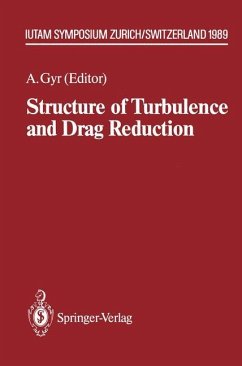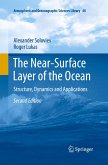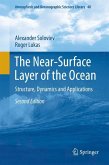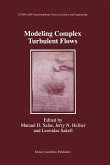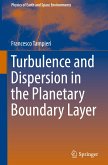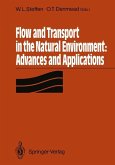Structure of Turbulence and Drag Reduction
IUTAM Symposium Zurich, Switzerland July 25¿28, 1989
Herausgegeben von Gyr, Albert
Structure of Turbulence and Drag Reduction
IUTAM Symposium Zurich, Switzerland July 25¿28, 1989
Herausgegeben von Gyr, Albert
- Broschiertes Buch
- Merkliste
- Auf die Merkliste
- Bewerten Bewerten
- Teilen
- Produkt teilen
- Produkterinnerung
- Produkterinnerung
In 1976 a similar titled IUTAM Symposium (Structure of Turbulence and Drag Reduction) was held in Washington . However, the progress made during the last thirteen years as weil as the much promising current research desired a second one this year. In Washington drag reduction by additives and by direct manipulation of the walls (compliant walls and heated surfaces) were discussed. In the meantime it became evident that drag reduction also occurs when turbulence is influenced by geometrical means, e.g. by influencing the pressure distribution by the shape of the body (airfoils) or by the…mehr
Andere Kunden interessierten sich auch für
![The Near-Surface Layer of the Ocean The Near-Surface Layer of the Ocean]() Alexander SolovievThe Near-Surface Layer of the Ocean112,99 €
Alexander SolovievThe Near-Surface Layer of the Ocean112,99 €![The Near-Surface Layer of the Ocean The Near-Surface Layer of the Ocean]() Alexander SolovievThe Near-Surface Layer of the Ocean113,99 €
Alexander SolovievThe Near-Surface Layer of the Ocean113,99 €![Modeling Complex Turbulent Flows Modeling Complex Turbulent Flows]() Modeling Complex Turbulent Flows119,99 €
Modeling Complex Turbulent Flows119,99 €![Turbulence and Dispersion in the Planetary Boundary Layer Turbulence and Dispersion in the Planetary Boundary Layer]() Francesco TampieriTurbulence and Dispersion in the Planetary Boundary Layer90,99 €
Francesco TampieriTurbulence and Dispersion in the Planetary Boundary Layer90,99 €![Flexible Ridesharing Flexible Ridesharing]() Volker HandkeFlexible Ridesharing75,99 €
Volker HandkeFlexible Ridesharing75,99 €![Laser in Environmental and Life Sciences Laser in Environmental and Life Sciences]() Laser in Environmental and Life Sciences113,99 €
Laser in Environmental and Life Sciences113,99 €![Flow and Transport in the Natural Environment: Advances and Applications Flow and Transport in the Natural Environment: Advances and Applications]() Flow and Transport in the Natural Environment: Advances and Applications75,99 €
Flow and Transport in the Natural Environment: Advances and Applications75,99 €-
-
-
In 1976 a similar titled IUTAM Symposium (Structure of Turbulence and Drag Reduction) was held in Washington . However, the progress made during the last thirteen years as weil as the much promising current research desired a second one this year. In Washington drag reduction by additives and by direct manipulation of the walls (compliant walls and heated surfaces) were discussed. In the meantime it became evident that drag reduction also occurs when turbulence is influenced by geometrical means, e.g. by influencing the pressure distribution by the shape of the body (airfoils) or by the introduction of streamwise perturbances on a body (riblets). In the recent years turbulence research has seen increasing attention being focused on the investigation of coherent structures, mainly in Newtonian fluids. We all know that these structures are a significant feature of turbulent flows, playing an important role in the energy balance in such flows. However their place in turbulence theories as weil as the factors influencing their development are still poorly understood. Consequently, the investigation of phenomena in which the properties of coherent structures are alte red provides a promising means of improving our understanding of turbulent flows in general.
Hinweis: Dieser Artikel kann nur an eine deutsche Lieferadresse ausgeliefert werden.
Hinweis: Dieser Artikel kann nur an eine deutsche Lieferadresse ausgeliefert werden.
Produktdetails
- Produktdetails
- IUTAM Symposia
- Verlag: Springer / Springer Berlin Heidelberg / Springer, Berlin
- Artikelnr. des Verlages: 978-3-642-50973-5
- Softcover reprint of the original 1st ed. 1990
- Seitenzahl: 640
- Erscheinungstermin: 22. August 2012
- Englisch
- Abmessung: 235mm x 155mm x 35mm
- Gewicht: 967g
- ISBN-13: 9783642509735
- ISBN-10: 3642509738
- Artikelnr.: 40769719
- Herstellerkennzeichnung Die Herstellerinformationen sind derzeit nicht verfügbar.
- IUTAM Symposia
- Verlag: Springer / Springer Berlin Heidelberg / Springer, Berlin
- Artikelnr. des Verlages: 978-3-642-50973-5
- Softcover reprint of the original 1st ed. 1990
- Seitenzahl: 640
- Erscheinungstermin: 22. August 2012
- Englisch
- Abmessung: 235mm x 155mm x 35mm
- Gewicht: 967g
- ISBN-13: 9783642509735
- ISBN-10: 3642509738
- Artikelnr.: 40769719
- Herstellerkennzeichnung Die Herstellerinformationen sind derzeit nicht verfügbar.
1 structure of Turbulence.- Reviews.- 1. Turbulent boundary layer structure: Progress, status, and challenges.- 2. A review of vortex structures and associated coherent motions in turbulent boundary layers.- Experiments in wall bounded turbulence.- 3. Hairpin vortices in turbulent boundary layers: The implications for reducing surface drag.- 4. Production of turbulence in boundary layers and potential for modification of the near wall region.- 5. Visualisation of the organized motion in a turbulent boundary layer.- 6. Analysis of experimental data on boundary layer pressure fluctuations in turbulent pipe flow.- Experinfients with free shear layers.- 7. Behaviour of separation bubble with different roughness elements at the leading edge of a flat plate.- 8. Organized structures and transition in the near field of a plane jet.- 9. Determination of regular structures in turbulent mixing processes by Raman scattering.- Theories of structures of turbulence.- 10. Wall layer eruptions in turbulent flows.- 11. Non-linear coherent mode interactions and the control of shear layers.- 12. Wavenumber-frequency spectral densities of turbulent wall pressure and wall shear fluctuations.- 13. Quadrant analysis and instantaneous momentum transport - a critical review.- 14. Artificial control of turbulent mixing layers.- 2 Drag Reduction in Dilute Polymer Solutions Injections of Concentrated Solutions.- Dilute polymer solutions Reviews.- 15. Dynamics of dilute polymer solutions.- 16. The effect of dilute polymer solutions on viscous drag and turbulence structure.- Theories of drag reduction by dilute polymer solutions.- 17. Aspects of mechanism in type B drag reduction.- 18. Change of structures close to the wall of a turbulent flow in drag reducing fluids.- Experiments with dilutepolymer solutions.- 19. The influence of polymer additives on the coherent structure of turbulent channel flow.- 20. Interaction of molecules and turbulent flow in dilute polystyrene solutions.- 21. A-shaped vortices in dilute polymer solutions.- 22. Wake flows in dilute polymer solutions.- Concentrated polymer solutions.- Review.- 23. Drag reduction caused by the injection of a polymer solution into a pipe flow.- Experiments with concentrated polymer solutions.- 24. Large eddies and polymer strings.- 25. Friction drag reduction by injection of polyethyleneoxide solution in a turbulent boundary layer through slot and perforated section.- 3 Drag Reduction by other means.- Reviews.- 26. Drag reduction in surfactant solutions.- 27. Turbulent drag reduction versus structure of turbulence.- Contributions to drag reduction by other means.- 28. Drag reduction by sand grain roughness.- 29. Effect of wall suction on the transport of a scalar by coherent structures in a turbulent boundary layer.- 30. Flow control by suction.- 31. Inertial interaction of spherical and fibre-like solid particles with turbulent flowing liquids.- 4 Stability and Computations.- Review.- 32. Hydrodynamic instability and coherent structures in turbulence.- stability.- 33. Effect of three-dimensional surface elements on boundary layer flow.- Computation.- 34. Interpretation of polymer drag reduction in terms of turbulence producing eddies close to the wall.- 35. Active turbulence control in wall-bounded flow using direct numerical simulations.- 5 Drag Reduction by Passive Means.- Review.- 36. Drag reduction by passive devices - a review of some recent developments.- Lebus.- 37. Relation between outer structures and wall-layer events in boundary layers with and without manipulation.- 38. Boundary layermanipulators at high Reynolds numbers.- 39. Large-scale turbulence structures in a manipulated channel flow.- 40. Analysis of the wake of an outer layer manipulator.- 41. Influence of an acoustic field on the flow structure behind a LEBU in a turbulent boundary layer.- 42. Analysis of the structure of a turbulent boundary layer, with and without a LEBU using light sheet smoke visualizations and hot wire measurements.- Riblets.- 43. The effects of longitudinal roughness elements and local suction upon the turbulent boundary layer.- 44. Turbulent drag reduction by nonplanar surfaces. A survey on the research at TU/DLR Berlin.- 45. Drag reduction in pipes lined with riblets.- 46. Drag reduction mechanisms and near-wall turbulence structure with riblets.- 47. The bursting process over drag reducing grooved surfaces.- 48. Riblets in internal flows with adverse pressure gradients.- 49. Experimental investigation of turbulent boundary layers manipulated with internal devices: riblets.- Panel Discussions.
1 structure of Turbulence.- Reviews.- 1. Turbulent boundary layer structure: Progress, status, and challenges.- 2. A review of vortex structures and associated coherent motions in turbulent boundary layers.- Experiments in wall bounded turbulence.- 3. Hairpin vortices in turbulent boundary layers: The implications for reducing surface drag.- 4. Production of turbulence in boundary layers and potential for modification of the near wall region.- 5. Visualisation of the organized motion in a turbulent boundary layer.- 6. Analysis of experimental data on boundary layer pressure fluctuations in turbulent pipe flow.- Experinfients with free shear layers.- 7. Behaviour of separation bubble with different roughness elements at the leading edge of a flat plate.- 8. Organized structures and transition in the near field of a plane jet.- 9. Determination of regular structures in turbulent mixing processes by Raman scattering.- Theories of structures of turbulence.- 10. Wall layer eruptions in turbulent flows.- 11. Non-linear coherent mode interactions and the control of shear layers.- 12. Wavenumber-frequency spectral densities of turbulent wall pressure and wall shear fluctuations.- 13. Quadrant analysis and instantaneous momentum transport - a critical review.- 14. Artificial control of turbulent mixing layers.- 2 Drag Reduction in Dilute Polymer Solutions Injections of Concentrated Solutions.- Dilute polymer solutions Reviews.- 15. Dynamics of dilute polymer solutions.- 16. The effect of dilute polymer solutions on viscous drag and turbulence structure.- Theories of drag reduction by dilute polymer solutions.- 17. Aspects of mechanism in type B drag reduction.- 18. Change of structures close to the wall of a turbulent flow in drag reducing fluids.- Experiments with dilutepolymer solutions.- 19. The influence of polymer additives on the coherent structure of turbulent channel flow.- 20. Interaction of molecules and turbulent flow in dilute polystyrene solutions.- 21. A-shaped vortices in dilute polymer solutions.- 22. Wake flows in dilute polymer solutions.- Concentrated polymer solutions.- Review.- 23. Drag reduction caused by the injection of a polymer solution into a pipe flow.- Experiments with concentrated polymer solutions.- 24. Large eddies and polymer strings.- 25. Friction drag reduction by injection of polyethyleneoxide solution in a turbulent boundary layer through slot and perforated section.- 3 Drag Reduction by other means.- Reviews.- 26. Drag reduction in surfactant solutions.- 27. Turbulent drag reduction versus structure of turbulence.- Contributions to drag reduction by other means.- 28. Drag reduction by sand grain roughness.- 29. Effect of wall suction on the transport of a scalar by coherent structures in a turbulent boundary layer.- 30. Flow control by suction.- 31. Inertial interaction of spherical and fibre-like solid particles with turbulent flowing liquids.- 4 Stability and Computations.- Review.- 32. Hydrodynamic instability and coherent structures in turbulence.- stability.- 33. Effect of three-dimensional surface elements on boundary layer flow.- Computation.- 34. Interpretation of polymer drag reduction in terms of turbulence producing eddies close to the wall.- 35. Active turbulence control in wall-bounded flow using direct numerical simulations.- 5 Drag Reduction by Passive Means.- Review.- 36. Drag reduction by passive devices - a review of some recent developments.- Lebus.- 37. Relation between outer structures and wall-layer events in boundary layers with and without manipulation.- 38. Boundary layermanipulators at high Reynolds numbers.- 39. Large-scale turbulence structures in a manipulated channel flow.- 40. Analysis of the wake of an outer layer manipulator.- 41. Influence of an acoustic field on the flow structure behind a LEBU in a turbulent boundary layer.- 42. Analysis of the structure of a turbulent boundary layer, with and without a LEBU using light sheet smoke visualizations and hot wire measurements.- Riblets.- 43. The effects of longitudinal roughness elements and local suction upon the turbulent boundary layer.- 44. Turbulent drag reduction by nonplanar surfaces. A survey on the research at TU/DLR Berlin.- 45. Drag reduction in pipes lined with riblets.- 46. Drag reduction mechanisms and near-wall turbulence structure with riblets.- 47. The bursting process over drag reducing grooved surfaces.- 48. Riblets in internal flows with adverse pressure gradients.- 49. Experimental investigation of turbulent boundary layers manipulated with internal devices: riblets.- Panel Discussions.

